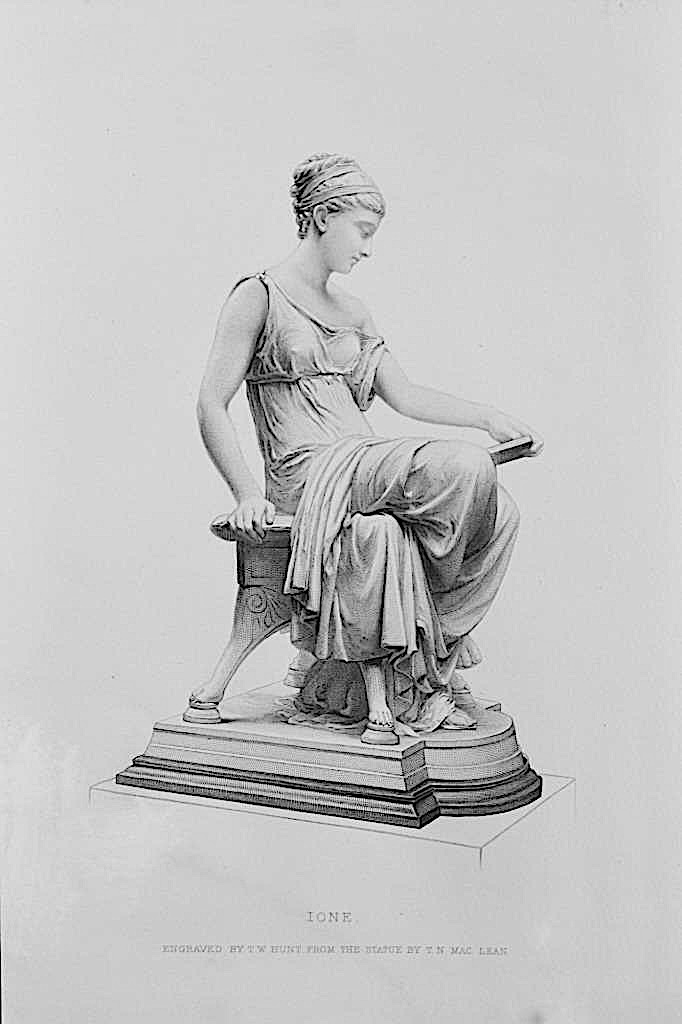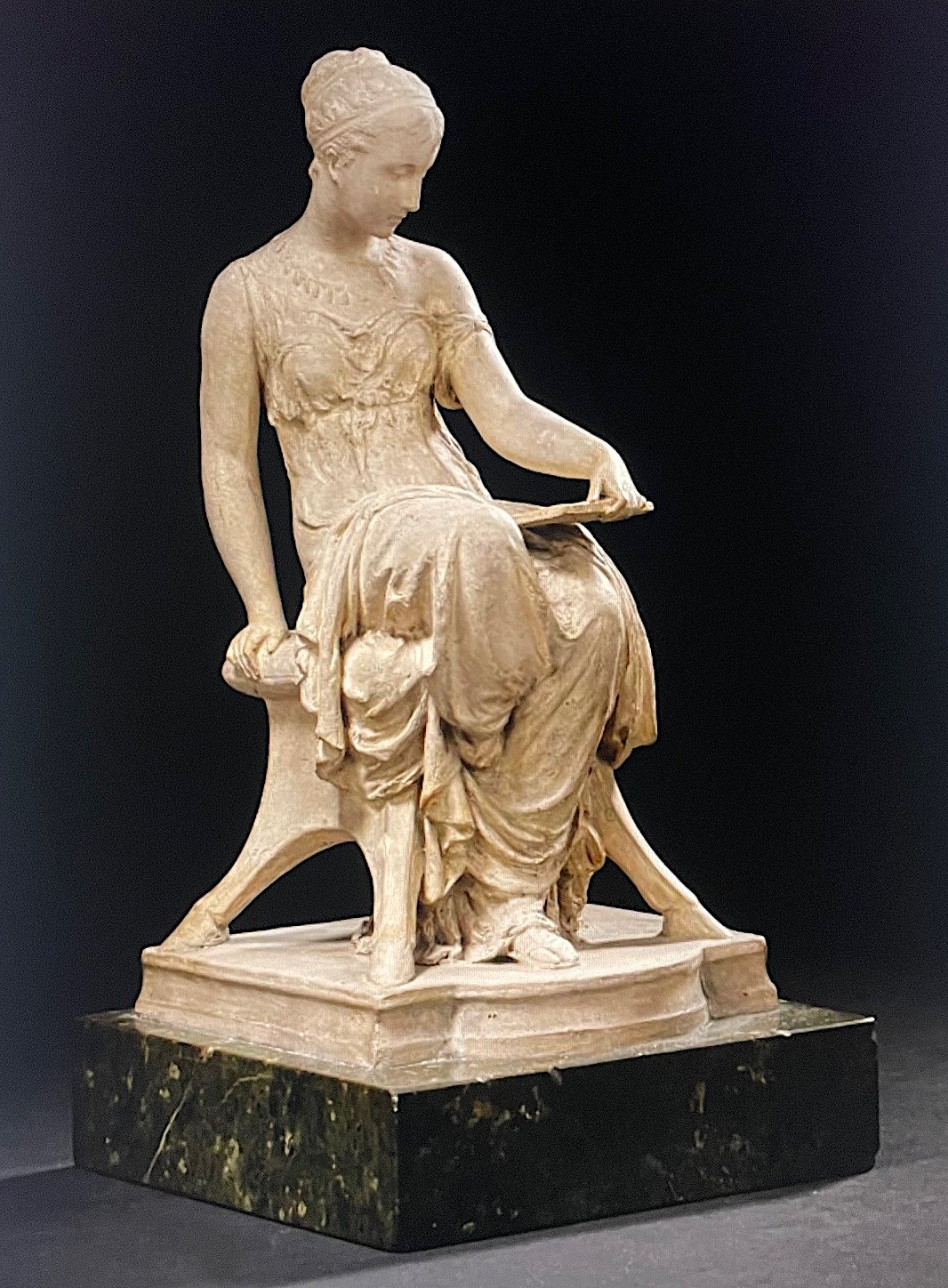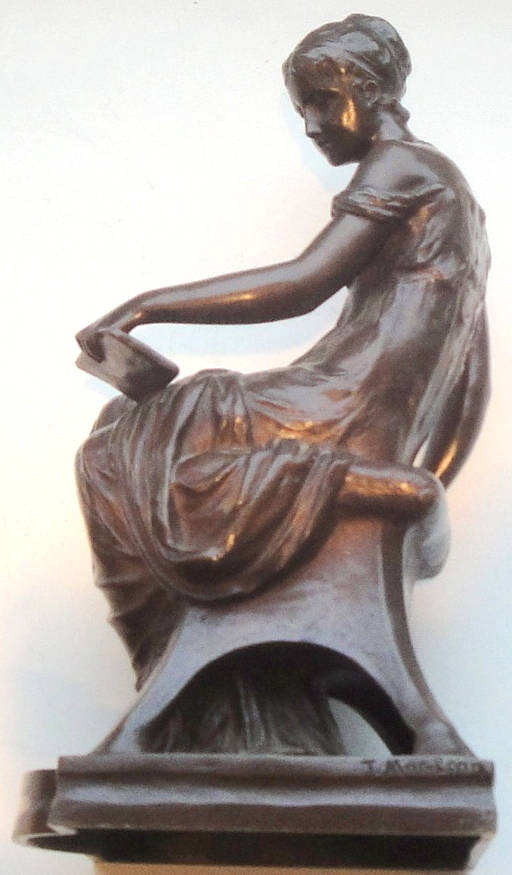
Ione. 1885. Thomas Nelson Maclean (1845-1894). Bronze sculpture, lost-wax cast published by Bellman & Ivey, Piccadilly. 10 inches (25.5 cm) high. Private collection. Image courtesy of the author. [Click on the images to enlarge them.]
In Greek mythology Ione was one of the fifty Nereids, the sea nymph daughters of the sea god Nereus and the Oceanid Doris. The Nereids were often depicted as the attendants of Poseidon, the god of the sea, and in ancient art they were portrayed as beautiful graceful young maidens. The Ione of MacLean's sculpture, however, was taken not from Greek mythology but from a character in Edward Bulwer Lytton's novel The Last Days of Pompeii.
An engraving of MacLean's marble version of the sculpture was reproduced in The Art Journal in 1880, accompanied by this caption:
"As a portrait sculptor Mr. McLean is successful, imparting unusual expression and vitality to the marble. In one of the grandest and most eloquent of modern novels, The Last Days of Pompeii, Sir E. Bulwer Lytton thus describes his lovely ideal heroine:
"Ione" was one of those brilliant characters which, "but once or twice flash across our career; she united in the highest perfection the rarest of earthly gifts, genius and beauty; genius beyond that of woman, keen, dazzling, bold. Poetry flows spontaneous from her lips; her imagination and her reason were not at war with each other, they harmonize and direct her course, as the winds and waves direct some lovely bark." The lovely Greek girl gathered round her, with an independence of action little known in Pompeii in those days, all whose taste and talents could please one so refined and intellectual, and Mr. McLean has chosen a moment when she is gazing with appreciative admiration upon the sketch of some Apelles, who came to claim for it her coveted approval. There is much grace in the rendering of the fair Ione; the ideal is admirably carried out in her noble and classic features; the pose of her head is easy and natural. Mr. McLean's style is elegant and pure. [272]

Engraving of Ione, by T.W. Hunt in black ink on off-white paper after the marble by T. N. MacLean. 11 x 7 inches (28 x 17.8 cm) – sheet size; 7 3/4 x 5 3/8 inches (19.6 x 13.6 cm) – image size. Reproduced from The Art Journal, 1880, facing p. 272.
Although trained largely in France, MacLean became a prominent member of the New Sculpture movement in England in the late nineteenth century. Susan Beattie has described his work as a "reticent, graceful style intermediate between late neo-classicism and New Sculpture (247). MacLean was particularly known for his classically-draped female figures and busts, notable among which was Ione, which Edmund Gosse referred to in 1883 as "hitherto the most popular of all this sculptor's works" (183). In 1875 an initial cast was exhibited at the Royal Academy in London, no. 1328, and then later at the Salon in Paris. A version in terracotta was shown at the Grosvenor Gallery in 1877, no. 1.
A marble version was then exhibited at the Royal Academy in 1879, no. 1524. Another cast was shown at the exhibition A Century of Artists held in conjunction with the International Exhibition held at Glasgow in 1888.
Even early in his career critics recognized MacLean as a rising star in British Sculpture circles. The cast shown at the Royal Academy in 1875 was described by James Blaikie as "of exceeding beauty and refinement, that at once placed the sculptor in the first rank of ideal artists" (235). Blaikie further described Ione as MacLean's "most distinctive and popular work" (236). The cast shown at the Royal Academy in 1875 was praised by a critic for The Architect for its refined and elegant lines:
"There are several pieces by this newcomer, T. N. MacLean; notably, a seated figure called Ione (1,328). The statue is singularly graceful in composing line, graceful even to a fault. The girl's limbs are crossed, and one foot only touches the ground, the right arm resting on the edge of her seat supports the body, the left holds the tablet on her knee. Between the head, torso, and extremities a perfect balance of proportion reigns, instead of a medley of models, as is common to the figures of English sculptors. The whole thing is entirely fresh and natural. If Mr. MacLean can add to grace and symmetry, vigour and character we shall hear good things of him" (329).

Ione in terracotta on a green marble base. 9½ inches (24 cm high). Private collection. Image courtesy of Hôtel Drouot, Paris.
In 1877 a reviewer for The Art Journal expressed admiration for the terracotta version shown at the initial exhibition of the Grosvenor Gallery, despite getting the sculptor's name incorrect: "and a terra-cotta Ione, by J. N. MacLean, a young British artist who has been trained in Paris, and from whom, if we judge by the sweet, beautiful creation just named, the Art-world has yet to expect much" (244).
MacLean's work was evidently much influenced by contemporary painters of Aesthetic Classicism, particularly Lawrence Alma-Tadema and Albert Moore. Alma-Tadema, in fact, seconded MacLean's unsuccessful application to become an Associate of the Royal Academy in 1878. Beattie felt Ione had much in common with the "classically draped, languorous maidens of Moore" (137). Beattie also felt that "the quiet grace of his style may well in turn have influenced the early work of sculptors such as Thornycroft [Hamo Thornycroft] and Onslow Ford who had no direct experience of Beaux-Arts training" (137). Blaikie, in particular, praised MacLean's modelling of drapery in his sculptures, which is exemplified by the skill displayed in Ione: "Mr. MacLean is an enthusiast in the matter of drapery. His study of the subject has been continuous and searching; his works abundantly exemplify with what thoroughness he has mastered the anatomy of folds, the exhaustive problems of light and shade, the potentialities of drapery, whether treated decoratively and in repose … or as the medium of expressing rhythmic movement or accentuating emotion…. In no branch of technique do we find the soundness of Mr. MacLean's training more strikingly manifest, or his science more deftly and delightfully employed than in his treatment of drapery" (236).


A bronze Ione from another private collection. This was featured on an earlier version of this page, where its measurements were given as 24 x 11½ x 12 cm. including self-base. MacLean's signature is seen on the base.
MacLean was interested in the lost-wax casting technique (cire perdue) and in the mass production of small-scale domestic bronzes. During the 1880s he published such work through Bellman & Ivey, Piccadilly, including this particular work. A cast of Ione was included on MacLean's solo exhibition at Bellman and Ivey's gallery at 17 Piccadilly, London, in 1885. The popularity of the work is attested to by the fact that versions were also produced in marble and terracotta. A version in terracotta was sold at Drouot in Paris on 31 January 2025, lot 208.
Bibliography
Beattie, Susan. The New Sculpture. . New Haven: Yale University Press, 1983.
Blaikie, James A. "An English Sculptor." The Magazine of Art IX (1886): 233-38.
Gosse, Edmund. "Living English Sculptors." The Century Magazine XXVI (June 1883): 163-85.
"Ione." The Art Journal New Series XIX (1880): 272.
Private Collections – Paintings, Furniture & Works of Art. Paris: Hôtel Drouot (31 January 2025): lot 208.
"The Grosvenor Gallery." The Art Journal New Series VI (1877): 244.
"The Royal Academy. – Sculpture." The Architect XIII (June 5, 1875): 329.
Created 19 April 2025